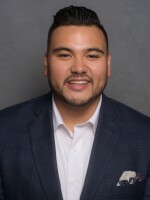Updated 10:10 a.m., June 23, 2020
With her children behind her, Danielle Humphries stood in her front yard weeping and yelling "Thank you!" to marchers passing by chanting “Black Lives Matter” across the street from Claggett Middle School in Medina.
“It’s hard to explain the feeling. I got chills,” Humphries said.

Danielle Humphries and her children got emotional as marchers passed by their Medina home on June 7. [Gabriel Kramer / ideastream]
In 2002, Humphries, who is Black, moved her family from Canton to Medina – a predominately-white suburb 40 minutes south of Cleveland.
“There’s always been kind of a thing here, you know, with Medina,” she said, explaining that she hasn't always felt welcome as a Black woman. “So, to see all those people was just wonderful.”
Black Lives Matter demonstrations have become a regular occurrence across America’s major cities – most notably in urban centers with large Black populations – since George Floyd's death under the knee of a Minneapolis police officer last month.
Cleveland, where about half of residents are Black, and Columbus, which is about 40 percent Black, both saw several protests; demonstrators continue to clash with police in Columbus.
But small, mostly white cities, where Black people make up less than 5 percent of the population, also have seen protests and rallies of their own.
The early June demonstration in Medina that moved Humphries to tears was organized by Mimi and Malik Tuck. The Tuck siblings, who now live in Columbus, were determined to make sure Black voices were heard in their hometown.
“If we’re going to make change, we have to make change with people who aren’t Black, as well," Malik Tuck said. "So I think it was important to go and speak to people in Medina to be like, ‘Hey, this is going on and if we’re going to make change, we need you guys to be fully aware of what’s happening and we have to challenge you to make change.'"

Malik Tuck, now a Columbus resident, graduated from Medina High School in 2011. [Gabriel Kramer / ideastream]
Medina’s population is about 92 percent white and less than 3 percent Black, according to the U.S. Census Bureau.
Its seven city council members and the mayor, who is in his third term in that office after having also served as the city's police chief, are all white.
The Tucks have been attending protests in Columbus. But because the demographics are so different in their hometown, the message they shared in Medina was tailored a little differently from what they heard in Columbus.
“The message that we more so are giving out [in Medina] was mainly directed towards people who are not aware of what Black people might be going though or not be aware of the prejudices they have,” Mimi Tuck said. “If we were to go somewhere like Cleveland or even here in Columbus, I think the message would be a little bit more towards Black empowerment.”

Mimi Tuck graduated from Medina High School in 2013. [Gabriel Kramer / ideastream]
The last few weeks have brought several different racial injustice demonstrations to Medina. And the suburb of about 26,000 people is not alone.
A large group rallied the first week of June in Chagrin Falls, where about 97 percent of the village’s 4,000 residents are white, according to census data.
“I’m very happy to say Chagrin provided a very safe environment for the people that wished to assemble and protest, as is their constitutional rights,” said Chagrin Falls Mayor Bill Tomko. “We protected the property in Chagrin and their rights and everybody was heard.”
Protests against racial injustice also popped up in Strongsville, Brecksville, Lakewood and other predominately white Northeast Ohio suburbs.
Ronnie Dunn, an urban studies professor at Cleveland State University, said he's surprised to see demonstrations in such suburbs. Having these kinds of protests in white communities, he said, is what separates this movement from similar periods of protest of the recent past.

Hundreds of people showed up for a demonstration in Lakewood Park on June 13. [Gabriel Kramer / ideastream]
“The fact that they’re now being held in predominately white suburbs and communities, that’s very heartening. I think that that is what is going to help tip the scales in the right direction," Dunn said. "Black and people of color alone, we can’t resolve racism in America. It takes white America to help address and resolve issues of race and racism.”
The real impact of protests in predominantly white communities, he said, will depend on whether the events lead to real policy changes.
Protests alone aren't enough, the Tuck siblings agree, back home in Medina or anywhere else.
“Just about every protest I’ve been to, I feel like afterwards I’m talking to people, I’m kind of like, ‘Okay, what’s next?’” said Mimi Tuck. “If you settle for the cautiously optimistic, you might almost be setting yourself up to not expect more.”
Malik Tuck added, “Once life, or America, goes back to quote unquote normal, are people going to get back to what they were doing or are they going to forget about it?”

The Medina demonstration ended at the Medina Public Square. [Gabriel Kramer / ideastream]
Humphries will never forget the June 7 march against racial injustice in Medina.
“That procession, it was the be-all and the end-all for me,” Humphries said, “it made me feel like a part of the community.”
Copyright 2020 90.3 WCPN ideastream. To see more, visit 90.3 WCPN ideastream. 9(MDAxMzY2MjQ0MDEyMzcyMDQ5MzBhZWU5NA001))





